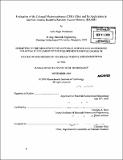Evaluation of the colossal electroresistance (CER) effect and its application in the non-volatile Resistive Random Access Memory (RRAM)
Author(s)
Wicaksono, Aulia Tegar
DownloadFull printable version (24.02Mb)
Other Contributors
Massachusetts Institute of Technology. Dept. of Materials Science and Engineering.
Advisor
Caroline A. Ross.
Terms of use
Metadata
Show full item recordAbstract
Flash memory, the current leading technology for non-volatile memory (NVM), is projected by many to run obsolete in the face of future miniaturization trend in the semiconductor devices due to some of its technical limitations. Several different technologies have been developed in attempt for replacing Flash memory as the most dominant NVM technology; none of which seems to indicate significant success at the moment. Among these technologies is RRAM (Resistive Random Access Memory), a novel type of memory technology which has only recently emerged to join the race. The underlying principle of an RRAM device is based on the colossal electroresistance (CER) effect, i.e. the resistance switching behavior upon application of voltage of varying polarity and/or magnitude. This thesis aims to investigate the CER effect and how it can be designed to be a non-volatile memory as well as other novel application, e.g. memristor. The various technical aspects pertaining to this phenomenon, including the materials and the physical basis, are explored and analyzed. As a complementary to that, the market potential of the RRAM technology is also assessed. This includes the market study of memory industry, the current intellectual property (IP) landscape and some of the relevant business strategies. The production strategy (i.e. the production cost, initial investment, and pricing strategy) is then derived from the technical and market analysis evaluated earlier and with using some reasonable assumptions.
Description
Thesis (M. Eng.)--Massachusetts Institute of Technology, Dept. of Materials Science and Engineering, 2009. Cataloged from PDF version of thesis. Includes bibliographical references (p. 79-81).
Date issued
2009Department
Massachusetts Institute of Technology. Department of Materials Science and EngineeringPublisher
Massachusetts Institute of Technology
Keywords
Materials Science and Engineering.